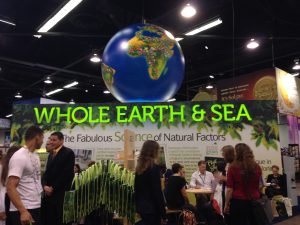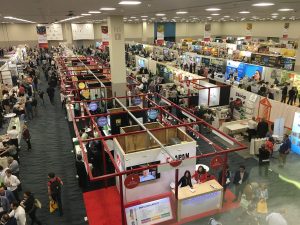Looking ahead to 2019: Steady as She Goes
Here at TradeshowGuy Exhibits, we’re doing a little planning for 2019, but frankly, not much will change. Over the years I’ve recognized that some things work better than others, so I tend to focus on the things that work and not spend much time on things that haven’t proven to be successful in the past.
Having said that, in a way a lot of it is unpredictable. So much of marketing and business is a crap shoot, especially when you’re a small business. In a sense, you have to keep doing the things that got you this far.
When it comes to generating new business, the two most consistent things I can do are to attend tradeshows and meet people and keep in touch with them over time. They say that a potential client needs to see or hear from you at least seven times before they might become a client. In this business, in my experience it’s usually more, so I keep in touch as best as I can with phone calls, email and the occasional snail mail. Of course, having a book or two to send to potential clients is a good advantage to have, too. Maybe I’ll write another one this year, who knows!
We’ll continue to work with Classic Exhibits out of thePortland area for the bulk of our exhibit design and fabrication. They’ve gotten better over the years and their skills at designing and customizing exhibits is continually improving. Having them essentially in my back yard (we’re about 45 minutes away from their shop) makes things easier.And having them as an extremely supportive partner makes it easy to work with them.
We also work with a number of manufacturers for differentitems such as banner stands, lights and other things, and will continue to workwith them. Foremost among those companies is Orbus, which has been a dependable partner for years.
We also work with Eagle Management for client installation and dismantle, TransGroup Global Logistics for shipping, Cort Events for furniture rental. Over the years we’ve tried other companies, many of which are dependable, but in the past couple of years these companies have been steady partners and will likely continue to be.
If we’re staying the course, going steady as she goes as the saying goes, what does that mean and are any new things planned?
First, you’ll continue to see weekly postings of a video and audio version of TradeshowGuy Monday Morning Coffee. As an old radio guy, sitting in front of a microphone (and laptop camera) is natural and easy and frankly fun. Guests are always great to have, and I strive to have them on the show more often than not, but if not, I typically find a topic to muse on for awhile. The objective, as I see it, is to share some personal and business observations, and great information as it comes. Guests and topics are generally event and tradeshow-oriented, but not exclusively. The idea is to attract non-event people if possible.
I’ll continue to post on the blog at least a couple of times a week. Guest posts are always welcome as guests typically bring a different perspective on a topic.
I’ll attend a handful of tradeshows, including NaturalProducts Expo West in March in Anaheim, where TradeshowGuy Exhibits has several clients. Other shows include the Northwest Food Service Show that bounces between Seattle and Portland year over year, and the Cannabis Collaborative Conference, where TradeshowGuy Exhibits will be exhibiting for the first time. There are a number of non-cannabis exhibitors there that support the industry and we hope to become a partner to companies in that space. Stay tuned to see how that goes – and find us in Space #420 at the Portland Expo on January 23rdand 24th, 2019.
As far as new things, I keep looking to work with strategic partners, such as branding agencies and graphic designers when it’s a good fit. You never know where projects come from, so I try to keep networking. And although I’m not a natural networker like some people, I do get better at it as time goes by. I currently belong to the Wilsonville, Oregon Tip Club, a B2B networking group that meets every month.
What about social media? So much time can be spent on social media – and so much can be wasted. I think there is a use for it – but as faras bring in business, it’s limited. My usage of social media such as Twitter, Facebook, Instagram and LinkedIn has decreased ever-so-slightly over the years because – as much as I’d love to have a consistent presence on those outlets –it comes down to a choice of how to spend my time. And most of the time it’s more important to work with clients and seek new ones. No doubt you face that choice, too. I’ll continue to be there when it makes sense.
Running a small business is challenging. But it’s fun. There’s almost nothing else I’d rather be doing (maybe skiing and playing the drums, but so far no one’s offering to pay me much for those skills!). So I’ll keep doing it, keep serving our current clients as well as I can, and keep searching for new exhibitors that want to work with someone who’s focused and dedicated to their success.
Best wishes for a great 2019! And…steady as she goes!






